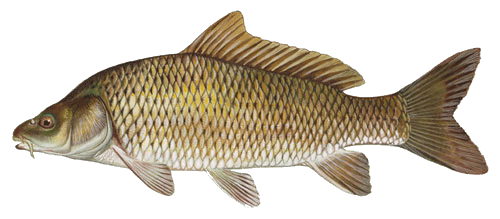| Common carp |  |
Common carp | | Cyprinus carpio carpio | (A.K.A. German carp, Mirror carp, Leather carp)
| Key Distinguishing Markings:
- There are two barbels on each side of the mouth. No other species that closely resembles the carp has these barbels.
- The carp's body is robust, deep and thick, and arched toward the dorsal fin.
- Carp have a lengthy dorsal fin, with nearly 20 soft rays. The dorsal fin extends well along the back, and the fin edge is high in the front and straight in back.
- The tail fin is forked and is often a "reddish" color.
- The first dorsal and anal fin spines are serrated.
- The typical carp's back is olive-brown to reddish brown, with the sides becoming silvery-bronze, brassy, or olive-gold. The belly is yellow or yellow-white. Most carp are bronze-gold to golden yellow on the sides and yellowish white on the belly.
- Lower fins are often reddish.
- Carp have a thick leathery appearance.
- Carp have very large dark-edged scales with a dark spot at the base.
- Their pharyngeal "teeth," located in the throat, are adapted for crushing. The larger ones look like human molars.
- Most carp are heavily scaled, but two genetic mutants show either few, extremely large scales (the "mirror carp") or no scales at all (the "leather carp").
View the Carp Gallery
| Distribution:
- Common carp are domesticated ancestors of a wild form native to the Caspian Sea region and east Asia.
- It is not known exactly when carp were brought to the United States from Europe, probably the mid-1800s to late 1800s. By 1880, the U.S. Fish Commission had distributed more than 12,000 carp to people in 25 states and territories to establish the fish in this country.
- One of the first species to be introduced into other countries, the carp now has a global distribution.
- Carp can be found in the brackish and fresh waters of the Chesapeake Bay, and in most freshwater rivers and impoundments statewide.
- Carp frequent shallow backwaters and shoreline habitat.
| Size:
- Carp are the largest member of the minnow family.
- Carp generally grow to about 30 inches and 10 to 15 pounds, but they can weigh up to 60 pounds.
| Habitat:
- Carp are hardy and tolerant of a wide variety of conditions but generally favor large water bodies with slow flowing or standing water and soft bottom sediments.
| Spawning:
- Common carp begin spawning in late April and continue into June over aquatic vegetation. Spawning areas are typically shallow, weedy bays (water depths of one to four feet).
- Spawning carp in shallow waters create a lot of commotion, and can be easily observed.
- Several males may spawn with a single female at a time.
- Large females release between 100,000 and 500,000 (up to two million for really large females!) sticky eggs over the spawning period. The eggs adhere to submerged vegetation or the bottom substrate.
- Eggs do not receive parental care, the adults abandon the eggs, which hatch in four to five days.
- After hatching young carp remain in these shallow, backwater areas until they are 3 to 4 inches in length, feeding during this time mainly on small crustaceans. Carp grow to four or five inches their first year of life.
- Carp reach sexual maturity in three to four years.
- Longevity ranges from 9 to 15 years, with some living 20 years and longer.
| Fishing Tips:
- Bottom fishing is the preferred method, due to the carp's feeding strategy.
- Carp can be caught with many different angling methods. Conventional equipment such as a cane pole, a throw line, or bait casting rods baited with dough balls, worms, crayfish tails, canned kernel corn, worms, and similar baits are all effective.
- Larger carp are particularly challenging to anglers because of their tackle-testing strength and heavy weights.
- Carp are also a popular target of bow anglers, especially when the fish move into shallow water to spawn.
- For current recreational size and creel limits, see Maryland's updated regulation page.
| Fun Fact:
- Adults uproot and destroy submerged aquatic vegetation and therefore may be detrimental to duck and native fish populations.
- Partly scaled or scaleless individuals are frequently caught by fishermen: these are known as "half-scaled," "mirror" or "leather" carp.
- Carp can be eaten but have a lot of bones unless prepared correctly. Favored cooking methods include barbecuing large carp on a grill or creating fish cakes from carp fillets.
- The state record carp captured in fresh water is 47 lbs., 8 oz. taken from a Frederick County farm pond in June 1997. The largest carp caught in the Chesapeake Bay weighed 44 lbs., 6 oz and was reeled in at Morgantown Beach in April 1978.
- The genus name "Cyprinus" is the old-world name for carp. "Carpio" is a Latinized word meaning "carp."
| | Family: Cyprinidae (Minnows or carps) | | Order: Cypriniformes (carps) | | Class: Actinopterygii (ray-finned fishes) | For more information on common carp and their management, please contact Alan Heft.
Illustration by Duane Raver
|
|
